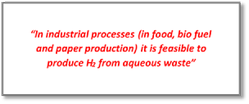 In situ spectroscopy methods can be used to study the structure of the catalytic active site and reaction sequences, under real reaction conditions. In this thesis Attenuated Total Reflection Infrared (ATR-IR) is discussed in detail. A Tunnel Cell with a cylindrical element, coated with a catalyst layer, is designed, and demonstrated to function under high temperature and pressure: 150-250 °C, 10-50 bar. ‘The conditions under which the spectroscopy cell functions are extreme,’ says Kamila Koichumanova. ‘These are needed for studying reactions at water/catalyst interfaces in aqueous phase reforming process.’
In situ spectroscopy methods can be used to study the structure of the catalytic active site and reaction sequences, under real reaction conditions. In this thesis Attenuated Total Reflection Infrared (ATR-IR) is discussed in detail. A Tunnel Cell with a cylindrical element, coated with a catalyst layer, is designed, and demonstrated to function under high temperature and pressure: 150-250 °C, 10-50 bar. ‘The conditions under which the spectroscopy cell functions are extreme,’ says Kamila Koichumanova. ‘These are needed for studying reactions at water/catalyst interfaces in aqueous phase reforming process.’
Efficient production of H2 from industrial waste streams is possible via aqueous phase reforming reaction using active catalyst at optimal conditions. ‘However, additional fundamental research on reaction mechanism is needed ,’ Kamila Koichumanova says.

‘We have to understand better what actually happens on the catalyst surface. Therefore we have developed a spectroscopic method to study the water/catalyst interface during the reaction. The first practical challenge of my PhD-work consisted of immobilizing the catalysts on the rod-shaped element that is used for internal reflection of IR-light in ATR-IR spectroscopy. We succeeded to come up with a reproducible method. We designed an ATR-IR Tunnel Cell and performed various simulations of hydrodynamic flow patterns in the cell.’
Unexpected result

Experiments on catalyst stability in hydrothermal conditions, confirmed the potential of the tunnel cell materials characterization. By studying the conversion of γ -Al2O3 to boehmite in real-time under hydrothermal conditions, Kamila demonstrated that this transformation results in catalyst deactivation, together with Pt sintering and blockage of the Pt surface with boehmite.
‘It was totally unexpected to be able to see the phase transformation in real time,’ she says. ‘Further detailed studies revealed the influence of other parameters on the phase transformation. The work resulted in a publication in PCCP (Physical Chemistry Chemical Physics) Journal.’
The application potential of Kamila’s work was highlighted by the University of Twente, saying: ‘In industrial processes: in food, bio fuel and paper production, it is feasible to produce H2 from aqueous waste. Finding the right feedstock composition and selecting the best catalyst, requires thorough research, in which the Tunnel Cell can play a vital role.’
Collaboration

During her PhD-project, Kamila collaborated with the Mesa+ Group: Soft Matter Fluidics and Interfaces. ‘Professor Rob Lammertink was of great help on computational hydrodynamics, making the whole study much more complete.’
Collaboration on theoretical chemistry took place with the University of Palermo. ‘Their expertise on Density Functional Theory calculations was of great importance. Using simulations we were able to calculate IR-spectra of the new molecules formed on the surface of the catalyst and support our peak assignments.
‘By using TEM and SEM equipment from the Mesa+ Nanolab we were able to characterize synthesized catalysts in detail on the nano-level. All these collaboration partners contributed to the successful outcome of this project.’
